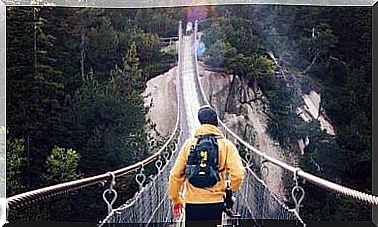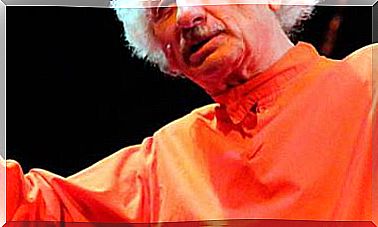The 4 Types Of Anxiety And Their Root Causes
The various types of anxiety derive from four basic forms: the fear of being, the fear of disappearing, the fear of remaining and the fear of changing.

Anxiety is an inevitable part of life. Under constantly changing forms, it accompanies us from the cradle to the grave. The history of humanity illustrates our never-ending effort to govern anxiety, to alleviate, overcome or overcome it.
What Causes Anxiety?
Magic, religion and science have tried ; The assurance of belief in God, devoted love, discovering the laws of nature or asceticism and the philosophical perspective do not eliminate our fear, but they can help to lighten its weight and, perhaps, to use it fruitfully in our development.
The belief that it is possible to live without anxiety will remain one of our illusions. The only thing we can do is try to cultivate forces that counteract it : courage, confidence, wisdom, power, humility, faith and love. These can help us accept anxiety, manage it, conquer it over and over again.
We should be skeptical of any method that promises us a life without anxiety ; it does not do justice to the reality of the human being and gives rise to illusory expectations.
If for a moment we observe anxiety “without anxiety”, we will see that it plays a double role: on the one hand, it can stimulate us; on the other, it can paralyze us. Anxiety is always a warning sign in case of danger, but at the same time it prompts us to overcome it.
The road to maturity
Accepting and knowing how to handle anxiety allows us to mature one step further. Avoiding anxiety and the need to control it, on the other hand, makes us stagnate, hinders our development and causes us to remain children in all those aspects where the obstacle of anxiety has not been overcome.
Anxiety always appears when we find ourselves in a situation that we cannot cope with, or that we are not yet ready to cope with. Every development, every step on the way to maturity, is a cause of anxiety, as it leads us to something new, something unknown for which we have not yet developed the necessary skills.
Along with the attraction of the new, the love of adventure and the thrill of risk, all novelty, everything unknown and experienced for the first time, contains a dose of anxiety. And as our lives constantly take us into unfamiliar territory, anxiety is our constant companion.
We are generally aware of this in important phases of our development, when we have to undertake new tasks and carry out changes. Developing, becoming an adult, and maturing, therefore, has a lot to do with mastering anxiety.
The basic forms of anxiety
In addition to these fears, there is a plethora of individual anxieties that we often cannot understand in others if we do not feel them: loneliness, crowds, airplanes, spiders, mice … But however varied it may seem the phenomenon of anxiety, are always variations of what I call “basic forms of anxiety”, which are related to our mentality about the world, our way of seeing it and our positioning in it.
We were born into a world, our planet, that obeys four powerful impulses. The Earth revolves around the Sun following a movement that we call translation. At the same time, the Earth also rotates around its own axis in a movement that we call rotational. This sets in motion two other contradictory or complementary impulses that make our system move continuously, but according to a pre-established course: the force of gravity and the centrifugal.
The gravitational force holds our planet together, pinning it toward its center. Centrifugal force, however, pushes outward, propelling us toward infinity. Only the balance between these impulses guarantees the natural order in which we live and that we call the cosmos.
According to this analogy, we are all subject to four fundamental imperatives that are reflected in the form of impulses, each contradictory but, at the same time, complementary to the others.
Rotation
The first imperative –which, following this allegory of the cosmos, corresponds to rotation– is that each of us should become a unique individual, affirming our being and our limits with others, developing an inimitable and differentiated personality from the rest.
Hence the anxiety that grips us when we separate from others and fall outside the usual parameters of security, belonging and community, which would imply loneliness and isolation.
Translation
The second imperative, which would correspond to the translational movement of the Earth around the Sun, is that we must confidently open ourselves to the world, to life and to others, that we should commit ourselves to the non-egoic, to what is strange to us, to the exchange with what is outside of us.
Hence, however, the anxiety of losing our ego, of becoming dependent, of surrendering ourselves, of not being able to live our life in accordance with our being, of sacrificing it for others and, under the demands of adaptation, having We give up too much of ourselves.
Thus, the first paradox is that life asks us to live according to the precepts of self-preservation and self-realization and, at the same time, according to those of surrender and overcoming the ego.
Centripetal force
The third imperative, which would correspond to the centripetal force of gravity, is that we should seek permanence, settle down and plan our future, be as ambitious as if we were to live forever, as if the world were a stable place and the future, predictable.
This imperative carries with it all the anxieties related to our mortality consciousness: the fear of venturing into the unknown, of making plans in the dark, of letting go with the flow of life that never stops.
However, if we had to renounce permanence, we would be unable to create and accomplish anything; Everything we produce must have something permanent, otherwise we would not even try to achieve our objectives.
Centrifugal force
Finally, the fourth imperative, corresponding to the centrifugal force, expects that we are always willing to change, to renounce the known, to abandon customs and see everything as merely transitory. This is how the second antinomy is drawn: we must aspire to permanence and change at the same time.
There are 4 types of anxiety
The four basic forms of anxiety, therefore, can be summarized as:
- The fear of giving up oneself, of experiencing ego dissolution and dependency.
- The fear of self-realization, felt as lack of protection and isolation.
- The fear of change, experienced as transience and insecurity.
- The fear of the permanent, experienced as irrevocability and slavery.
All possible forms of anxiety are ultimately variations of these four and are connected to the four basic drives that are part of our being, and they complement and contradict each other.
The prevalence of one or the other of these four forms determines our character structures, four ways of being in the world, with all its variations and degrees. The more marked and one-sided the personality structure described here, the more likely it is to arise from developmental disorders in early childhood.
At the same time, it would be a sign of good mental health if one managed to live with the four basic impulses in dynamic balance ; this would mean that the person would have dealt with the four basic forms of anxiety.
All four personality structures are normal, with certain accents. If these are markedly one-sided, they give rise to the four great neurotic character variants described by psychotherapy and deep psychology: schizophrenia, depression, compulsion, and hysteria.
Fritz Riemann (1902-1979). Psychoanalyst. One of his best known works is Anxiety (Reinhardt), from which this article has been edited.









